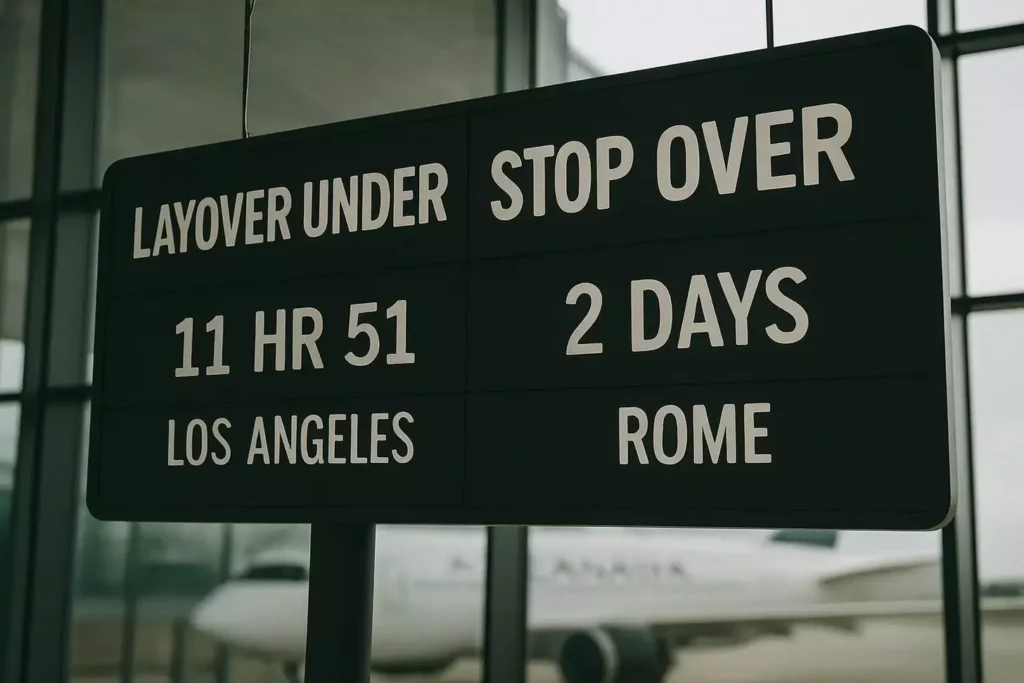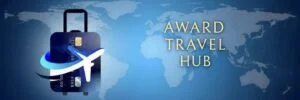Affiliate Disclosure: Award Travel Hub may earn a commission or referral bonus from some links on this site. These affiliate links help support our work and may influence the placement or promotion of certain products or services. However, our content is independently crafted to reflect honest opinions. Not all offers or products are included. There is no additional cost to users when they utilize our affiliate links.
Can one extra stop turn a standard ticket into a mini world tour? We think it can.
One of the program’s best tricks is the ability to include a stopover on a one-way award for just 5,000 points per passenger. This turns a single flight into two destinations without buying two tickets or juggling separate itineraries.
We walk you through where stopovers work, how long they can last (between 24 hours and 45 days), and the smart booking paths that save time and points. You’ll see why partner awards often follow the region-and-distance chart, while Air Canada pricing can be dynamic.
Along the way, we explain tools we use—segment searches and Great Circle Mapper—to keep distance bands favorable. Expect clear examples, step-by-step booking tips, and practical warnings so your rewards stretch further on every trip.
Key Takeaways
- A stopover can add a second destination to one award for minimal extra points.
- Stopovers must be outside the U.S. and Canada and last 24–45 days.
- Book simple routings online via Air Canada’s Multi-city tool; complex trips may need a phone call.
- Use Great Circle Mapper and segment searches to stay within lower-distance bands.
- Partner awards often offer steadier value than dynamic carrier pricing.
Why Aeroplan stopovers are a game-changer for award travel
A modest points add-on can turn one award into a multi-stop adventure without buying another ticket.
We can use one stopover on a one-way award and two on a round-trip, each costing the same fixed increment in points. That lets us split long journeys, see an extra destination, and avoid purchasing a separate award.
By stitching together flights on multiple partner airlines, we expand access to scarce seat space. If nonstop saver space is missing, routing through an intermediate city and adding a stopover often unlocks workable options.

Practical benefits
- Turn one trip into two with meaningful time at the stop.
- Use creative routings that stay inside distance bands.
- Break up long-haul travel to reduce fatigue and improve comfort.
- Match partners on key segments to keep the itinerary bookable.
| Feature | One-way | Round-trip |
|---|---|---|
| Max stopovers | 1 | 2 |
| Typical benefit | Add a second destination | Two-stop mini world routing |
| Best use | Stretch partner award space | Build complex itineraries |
A Summary of Aeroplan’s stopover rules
Before you book, we outline the rules governing stopovers, including costs and routing limits.
Cost, duration, and where they apply
Cost: Each stopover adds exactly 5,000 points to the award price per traveler on a one-way flight. On a round-trip, you can include up to 2 stopovers.
Geography: Stopovers are not allowed inside the U.S. or Canada (including Alaska and Hawaii). They are permitted across Mexico, the Caribbean, Central and South America, Europe, Africa, Asia, and island regions.

Layover vs. stopover: the 24-hour rule
A layover lasting less than 24 hours does not trigger extra points. A layover lasting less than 24 hours does not trigger extra points.
A stopover lasting 24 hours to 45 days qualifies and requires the 5,000 points add-on.
Routing logic, backtracking, and segment limits
- Logical routing: You can’t backtrack through the same airport once you’ve passed it. Routes must stay reasonable — generally not more than twice the direct distance between origin and destination.
- Zones: Single-zone awards must remain inside that zone to keep the price valid.
- Segments: The online tool supports up to 4 flights per direction; partner one-way itineraries can support up to 6 segments. Air Canada-operated tickets may have tighter internal rules.
| Rule | Limit | Practical tip |
|---|---|---|
| Duration | 24 hours–45 days | Use nights at the stop to meet minimums |
| Geography | Outside U.S./Canada only | Check region eligibility before pricing |
| Segments | 4 (online) / 6 (partners) | Search segment-by-segment to confirm space |
How Aeroplan pricing works: regions, distance bands, and the 5,000-point add-on
Understanding how pricing ties to regions and flight distance unlocks smarter award routings.
We use a hybrid system: the world is grouped into North America, Atlantic, Pacific, and South America, and awards price by both the regions crossed and the total distance flown.
Partner awards usually follow fixed bands on the award chart. That makes award pricing predictable when partner space is available.
When carrier pricing turns dynamic
Air Canada often applies dynamic price ranges to its own flight inventory. That means the same routing can vary by date or demand, even though distance still matters.
Using distance tools to protect the price
We recommend mapping total miles with Great Circle Mapper to keep your itinerary under the next distance band.
Example: Newark–Zurich (stop)–Johannesburg totals 9,157 miles and lands in a North America‑to‑Atlantic band. That itinerary prices at 115,000 points in business when you include the 5,000‑point stopover add.
| Factor | Behavior | Practical tip |
|---|---|---|
| Regions | Zone-based baseline | Check which zones your routing touches |
| Distance | Band thresholds affect the award | Use mapping to stay below higher bands |
| Carrier pricing | Partners: fixed chart; Air Canada: dynamic | Compare dates and carriers for the best points cost |
In short, the stopover tacks 5,000 points onto whatever award band your route hits. Know the chart bands, watch miles, and shop carriers to lower the final cost in points.
Plan your itinerary: finding award space and building a logical route
Begin with segment-level searches to avoid building an itinerary that can’t be ticketed. This method prevents surprises and keeps the final booking quick.
Search segment-by-segment to confirm availability. Start by locking long-haul partner flights, then verify the shorter legs into and out of your stopover. Capture flight numbers, dates, and cabin class as you go — that makes the final booking smoother, especially if you must call to ticket.
Tools to use: Air Canada, United, and third-party finders
Use United.com’s 30-day calendar to quickly scan Star Alliance availability, then switch to Air Canada to assemble and price the award. Third-party sites like PointsYeah, SeatSpy, and seats.aero helps reveal patterns on specific routes and cabins.
Always total the miles with Great Circle Mapper so your routing stays inside the distance band that matches your target price. If you start from a smaller airport, allow extra flexibility with dates or nearby cities to widen options.
- Confirm each flight segment before stitching the full itinerary.
- Lock long-haul partner segments first, then add short feeder flights.
- Validate the final price on Air Canada’s site and ensure the stopover is recognized.
- Be ready to call if the online tool can’t price complex routings; having flight numbers speeds the call.
Aeroplan Stopovers: Add a City for 5,000 Points — step-by-step booking
Booking a deliberate stop on a one-way award can stretch your trip into two destinations with minimal extra points. Below, we walk through the online flow and the fallback of calling in when the site can’t price complex routings.
Online with Multi-city: Start at Air Canada’s booking page. Choose Multi-city, check Book with points, then click Add a stopover for Flight 1. Enter origin, stopover, final destination, dates, and the number of nights to define stopover length.
Days count as nights at the stopover. If you arrive after midnight on an overnight flight, that first night counts toward the stopover total.
Phone booking for complex trips
If your itinerary goes past the site’s four-flight limit or the engine rejects logical routings, call to book. Have your flight numbers researched and ready. Agents can often assemble multi-carrier awards, but expect a $30 non‑refundable fee.
- Build segments in order: outbound to the stop, onward to the final destination, then the return.
- The stopover cost is included in the award total once the system recognizes it—no separate line item shows up.
- Double-check fare class and cabin on every flight before you ticket.
- After booking, reserve seats and set schedule-change alerts for each airport segment.
| Action | Online | Phone |
|---|---|---|
| Max flights per direction | Up to 4 | Up to 6 (agent-dependent) |
| Stopover entry | Click “Add a stopover for Flight 1” | Provide flight numbers and dates to the agent |
| Extra cost | 5,000 points added to the award total | $30 booking fee if an agent is required |
Real-world examples to inspire your next trip
Real itineraries show how one well-placed stop can convert a standard award into a multi-destination trip.
Stopover on a one-way: North America to the Pacific via Istanbul
Example: Boston → Istanbul → Jakarta in business prices from the North America–Pacific chart at 87,500 points base. Adding the stop increases the total to 92,500 points for the one-way flight.
Round-trip with two stopovers: a mini round-the-world
Try Montreal → Seoul (stop) → Bangkok outbound at 92,500 points, then return Bangkok → Munich (stop) → Montreal at 92,500 points.
That totals 185,000 points in business and gives extended time in three destinations across two continents.
Sample pricing: New York to Johannesburg via Zurich or Addis Ababa
Newark → Zurich (stop) → Johannesburg equals 9,157 miles and prices near 115,000 points in business with the stop included.
If space in Zurich is tight, route via Addis Ababa on partner airlines for similar pricing and availability.
- Europe sampler: stitch Lisbon and Madrid, then return via Frankfurt to deepen one award.
- Middle East connectors: Use Abu Dhabi as a hub en route to South Asia for better premium flights.
- Cabin strategy: lock long-haul business legs first, then add regional flights and local airports.
| Example | Mileage / Band | Points (business) |
|---|---|---|
| Boston → Istanbul → Jakarta | — / North America–Pacific | 92,500 |
| Montreal → Seoul → Bangkok (RTW style) | — / multi-zone | 185,000 (round-trip total) |
| Newark → Zurich → Johannesburg | 9,157 miles | 115,000 |
How to earn Aeroplan points in the United States
Earning transferable points and choosing the right card mix gets us to award bookings faster.
Transfer partners: American Express, Chase, Capital One, Bilt, Marriott
We move points quickly from American Express Membership Rewards, Chase Ultimate Rewards, Capital One miles, and Bilt Rewards at roughly 1:1. Transfers are usually near‑instant, which helps when we need to lock flights fast.
Marriott Bonvoy converts at 3:1 and adds a 5,000‑point bonus per 60,000 transferred. We use Marriott only to top up because the value is lower and transfers can take longer.
When to use co-branded vs. transferable points
Transferable points win when flexibility matters. They let us chase partner award space and move between programs to protect value.
Co‑branded cards shine for frequent flyers who want consistent earnings, perks on Air Canada, and an immediate welcome bonus tied directly to the airline program.
- Align new card applications with improved offers to maximize the welcome bonus and reduce the total number of cards opened.
- Funnel everyday purchases—dining, groceries, travel—into the card that pays most in each category.
- Only transfer when ready to book to avoid stranded balances and preserve optionality.
| Source | Ratio | Best use |
|---|---|---|
| American Express / Chase / Capital One / Bilt | 1:1 | Fast transfers; book time‑sensitive awards |
| Marriott Bonvoy | 3:1 (+5k/60k) | Top‑up route only; lower value |
| U.S. co‑branded card | On‑card earn & bonus | Frequent flyers who value airline perks |
“Transfer only when you’re ready to ticket; speed and flexibility beat hoarding.”
Conclusion
In short, a single one-way award can be split into two stays with only a modest points surcharge, making your trip more rewarding without doubling the cost.
We recommend planning for 24 hours up to 45 days at the stop, keeping routes logical and within distance limits, and pricing against the award chart before you ticket.
Book a stopover online with the Multi-city tool when possible. Call only if the site can’t price complex routings, and expect a $30 phone fee. Earn and transfer points via major partners and the right credit card mix, then move miles when you’re ready to book.
Pick your destination, choose a second city you’ve been curious about, and use the program’s stopover option to turn one award into a bigger, better journey.



